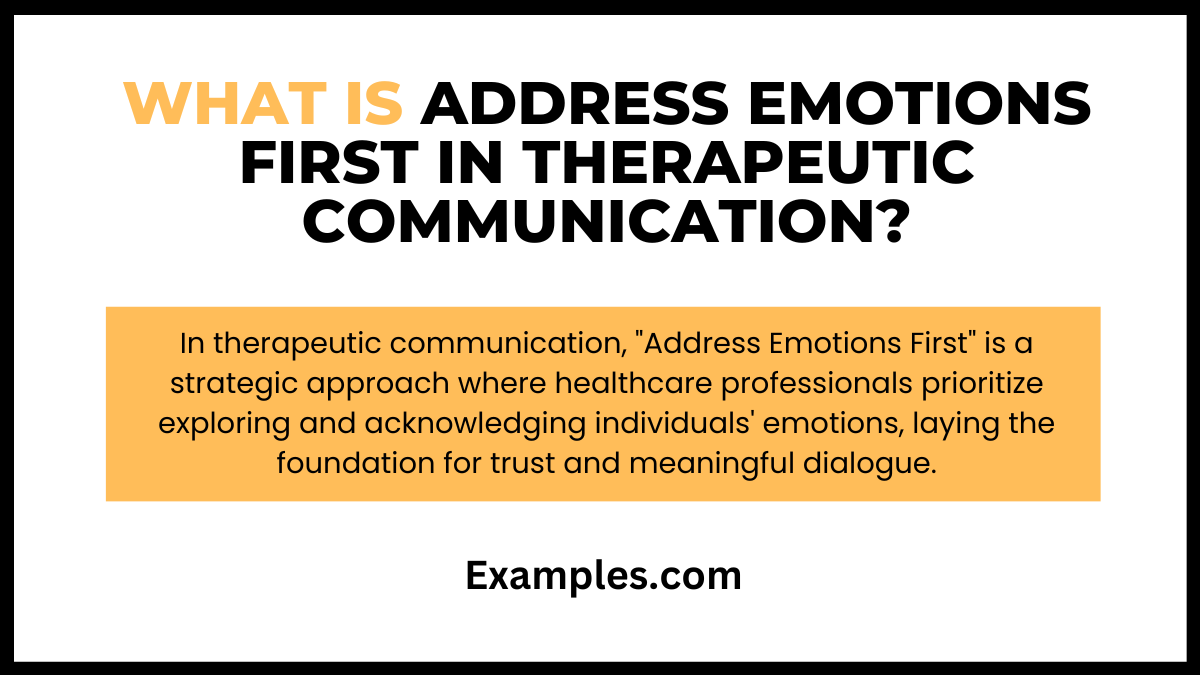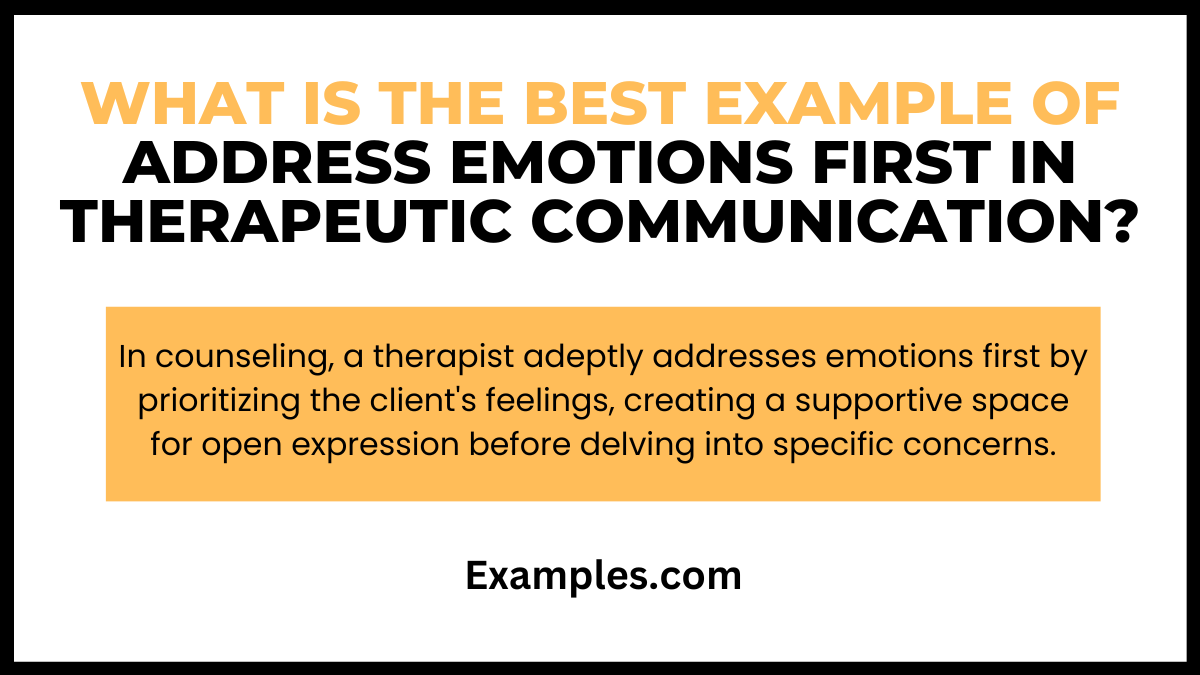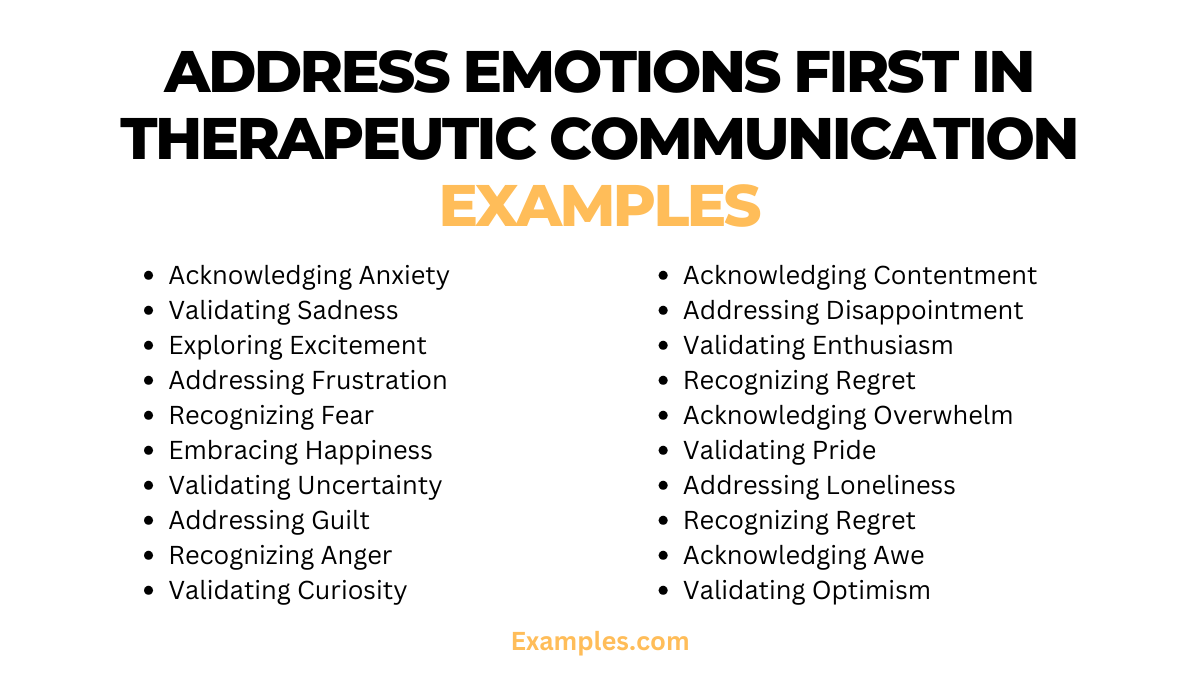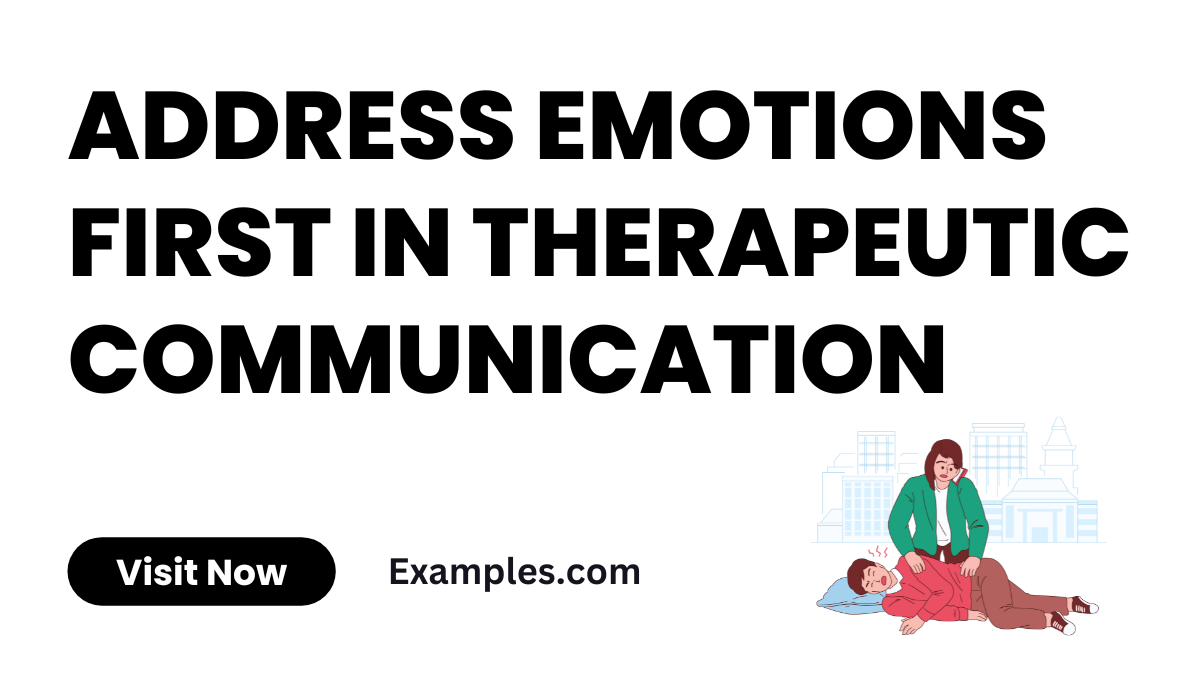19+ Address Emotions First in Therapeutic Communication Examples
Unlock the essence of therapeutic connection by Addressing Emotions First in Therapeutic Communication. This comprehensive guide delves into the art of prioritizing emotions, fostering a deeper understanding between professionals and clients. Enriched with Communication Examples, discover effective strategies to navigate emotional landscapes, creating a supportive environment for meaningful dialogue. Elevate your therapeutic practice with insights, examples, and expert guidance that transcends traditional communication boundaries.
What is Address Emotions First in Therapeutic Communication?

In therapeutic communication, “Address Emotions First” is a strategic approach where healthcare professionals prioritize exploring and acknowledging the emotional state of individuals before delving into other aspects. This technique involves actively recognizing and validating emotions as a crucial step to establish trust, build rapport, and create a supportive environment. By addressing emotions first, professionals lay the foundation for meaningful dialogue, allowing individuals to express themselves authentically and fostering a deeper connection within the therapeutic relationship.
What is the Best Example of Address Emotions First in Therapeutic Communication?

In a counseling session, a therapist adeptly addresses emotions first by saying, “Before we delve into any specific concerns, I’d like to understand how you’re feeling today. Your emotions matter, and this space is for you to express them openly.” This approach ensures the client’s emotional well-being takes precedence, fostering a supportive atmosphere and signaling the therapist’s commitment to understanding and validating the client’s emotions before addressing other therapeutic aspects.
20 Address Emotions First in Therapeutic Communication Examples

These examples showcase the versatility of addressing emotions first, creating a foundation for empathy, understanding, and transformative therapeutic experiences.
- Acknowledging Anxiety: “I sense some anxiety. Let’s explore what might be causing it, creating a safe space for you to share your feelings.”
- Validating Sadness: “I see a hint of sadness. Your emotions are valid; let’s delve into what’s contributing to this emotion today.”
- Exploring Excitement: “Excitement is palpable. Share more about what’s sparking joy for you, and let’s celebrate those positive emotions.”
- Addressing Frustration: “Frustration seems present. Your feelings matter; let’s navigate through what might be causing this frustration together.”
- Recognizing Fear: “Fear may be present. It’s okay; your emotions guide us. Share more about what’s causing this fear for you.”
- Embracing Happiness: “Happiness is evident. Let’s explore these positive emotions and uncover what contributes to your sense of joy.”
- Validating Uncertainty: “Uncertainty is normal. Your doubts are valid; let’s work through them together to provide clarity and support.”
- Addressing Guilt: “I sense some guilt. It’s essential to acknowledge and understand; share your feelings, and we’ll navigate through it together.”
- Recognizing Anger: “Anger is apparent. Your emotions are valid, and expressing them helps us understand the root causes.”
- Validating Curiosity: “Curiosity is a great starting point. Let’s explore your questions and interests, creating a space for learning and growth.”
- Acknowledging Contentment: “Contentment is wonderful. Share more about what contributes to your sense of peace and satisfaction.”
- Addressing Disappointment: “Disappointment may be present. Your feelings are significant; let’s discuss and navigate through them together.”
- Validating Enthusiasm: “Enthusiasm is contagious. Dive into what excites you, and let’s explore how to harness that positive energy.”
- Recognizing Regret: “Regret is a complex emotion. Your acknowledgment is the first step; let’s delve into understanding and healing.”
- Acknowledging Overwhelm: “Feeling overwhelmed is common. Share the burden, and together, we’ll navigate through the challenges you’re facing.”
- Validating Pride: “Pride is evident. Celebrate your achievements; let’s explore how to build on this sense of accomplishment.”
- Addressing Loneliness: “Loneliness is a powerful emotion. Your acknowledgment is crucial; let’s discuss ways to foster connection and support.”
- Recognizing Regret: “Regret is a complex emotion. Your acknowledgment is the first step; let’s delve into understanding and healing.”
- Acknowledging Awe: “Awe is a beautiful emotion. Share what’s inspiring this sense of wonder, and let’s explore its significance.”
- Validating Optimism: “Optimism shines through. Let’s nurture this positive outlook and discuss ways to sustain it in your journey.”
Address Emotions First in Therapeutic Communication for Nurses Examples
In the healthcare realm, nurses play a vital role in addressing emotions first, fostering a compassionate environment. This guide offers concise examples for nurses to navigate emotional landscapes effectively:
- Expressing Empathy:“Begin with a compassionate acknowledgment of the patient’s emotions, showing empathy and understanding.”
- Creating a Safe Space:“Establish a safe environment where patients feel comfortable sharing their emotions without judgment or fear.”
- Validating Patient Concerns:“Acknowledge and validate patient concerns, expressing a genuine understanding of their emotional state.”
- Active Listening:“Practice active listening to discern subtle emotional cues, allowing for a more profound understanding of patients’ feelings.”
- Encouraging Emotional Expression:“Encourage patients to openly express their emotions, providing a platform for authentic dialogue and connection.”
- Addressing Anxiety:“Proactively address anxiety by acknowledging its presence and working collaboratively to alleviate patient concerns.”
- Navigating Grief:“Guide patients through the grieving process with sensitivity, offering support and understanding during challenging times.”
- Promoting Trust:“Build trust by prioritizing emotional acknowledgment, creating a foundation for a strong nurse-patient relationship.”
- Cultural Sensitivity:“Be culturally sensitive to varying expressions of emotions, respecting and understanding diverse perspectives.”
- Instilling Hope:“Incorporate a sense of hope into therapeutic interactions, inspiring patients with positive and uplifting emotional support.”
Address Emotions First in Therapeutic Communication for Patients Examples
In patient care, addressing emotions first is pivotal for establishing trust and providing holistic support. Explore ten distinct examples enriched with Communication Examples, showcasing the significance of prioritizing patients’ emotional well-being.
- Recognizing Anxiety:“I sense some anxiety. Let’s discuss what might be causing it to ensure you feel supported and understood.”
- Validating Sadness:“If there’s sadness, it’s crucial to acknowledge. Your feelings matter; let’s explore and navigate through them together.”
- Exploring Hope:“Hope is vital. Share your sources of hope, and let’s integrate them into your journey for a positive therapeutic experience.”
- Addressing Pain:“If there’s pain, emotional or physical, it’s essential to address. Your well-being is our priority; let’s discuss and manage it.”
- Recognizing Resilience:“Resilience is admirable. Let’s explore the strengths that contribute to your resilience and leverage them in your care.”
- Validating Uncertainty:“Uncertainty is normal in healthcare. Acknowledge your concerns, and we’ll work together to navigate through the uncertainties.”
- Addressing Trust Issues:“If trust is a concern, let’s openly discuss it. Your trust in the therapeutic relationship is crucial for positive outcomes.”
- Recognizing Gratitude:“Gratitude is powerful. Share what you’re grateful for, and let’s integrate these positive elements into your care plan.”
- Acknowledging Fear of the Unknown:“Fear of the unknown is understandable. Let’s explore these fears, providing information and support for a more informed perspective.”
- Validating Empowerment:“Feeling empowered is significant. Share instances where you feel in control, and let’s build on that empowerment for better outcomes.”
Importance of Addressing Emotions in Therapeutic Communication?
In the realm of therapeutic communication, recognizing and addressing emotions play a pivotal role in establishing a profound connection between healthcare providers and individuals seeking care. The importance of addressing emotions is underscored by several key factors:
1. Building Trust and Rapport
Prioritizing emotions fosters trust, as individuals feel seen and heard, laying the foundation for a strong therapeutic alliance.
2. Creating a Safe Space
Addressing emotions creates a safe and non-judgmental environment, encouraging individuals to openly express their feelings without fear of criticism.
3. Tailoring Care to Individual Needs
Understanding emotions allows healthcare professionals to tailor care plans to individual emotional states, ensuring interventions align with the person’s unique needs.
4. Enhancing Communication
Addressing emotions promotes effective communication by acknowledging and validating feelings, facilitating open and honest dialogue.
5. Holistic Care Approach
Recognizing emotional well-being as integral to overall health supports a holistic approach to patient care, considering emotional and mental aspects alongside physical health.
6. Identifying Underlying Concerns
Proactively addressing emotions aids in uncovering underlying concerns, contributing to a comprehensive understanding of an individual’s health status.
7. Empowering Patients
Acknowledging emotions empowers individuals, involving them in their care journey and fostering a sense of control over their well-being.
8. Preventing Emotional Distress
Proactively addressing emotions helps identify and prevent potential emotional distress, allowing for timely intervention and support.
9. Promoting Mental Health
Emphasizing emotional well-being contributes to mental health promotion, recognizing the interconnectedness of emotional and mental states.
10. Improving Patient Satisfaction
A focus on emotions enhances the overall patient experience, contributing to higher satisfaction as individuals feel valued and supported in their healthcare journey.
Tips for Effective Address Emotions First in Therapeutic Communication?
Addressing emotions first in therapeutic communication is a nuanced skill that requires empathy, sensitivity, and strategic engagement. Implementing this approach effectively can significantly enhance the therapeutic relationship and overall patient experience. Here are key tips for healthcare professionals:
1. Cultivate Empathy:
Develop a genuine understanding of the individual’s emotional state by actively listening and empathizing with their experiences.
2. Non-Verbal Cues:
Pay attention to non-verbal cues such as body language and facial expressions to gauge emotional nuances that may not be explicitly communicated.
3. Open-Ended Questions:
Utilize open-ended questions that encourage individuals to express their feelings without constraints, fostering a more profound exploration of emotions.
4. Active Listening:
Practice active listening to demonstrate genuine interest and validate the emotions expressed, creating a safe space for open dialogue.
5. Establish Trust:
Prioritize trust-building by assuring individuals that their emotions are valued and will be respected, creating a foundation for a supportive therapeutic alliance.
6. Normalize Emotions:
Normalize the experience of emotions, letting individuals know that their feelings are valid and a natural part of the healing process.
7. Patient-Centered Approach:
Tailor your approach to the individual’s unique emotional needs, ensuring that the therapeutic process aligns with their preferences and comfort level.
8. Acknowledge Diversity:
Recognize and respect cultural and individual differences in expressing and perceiving emotions, promoting a culturally sensitive approach.
In conclusion, prioritizing the “Address Emotions First” approach in therapeutic communication is pivotal. By acknowledging and validating emotions at the forefront, healthcare professionals establish a foundation of trust and support. This nuanced strategy fosters meaningful connections, allowing individuals to authentically express themselves. Ultimately, embracing this approach contributes to a more effective and empathetic therapeutic relationship, positively impacting overall well-being.



